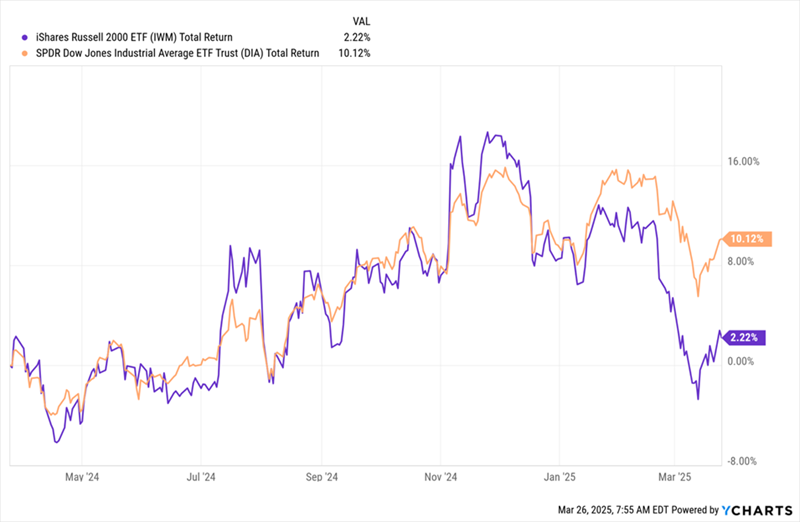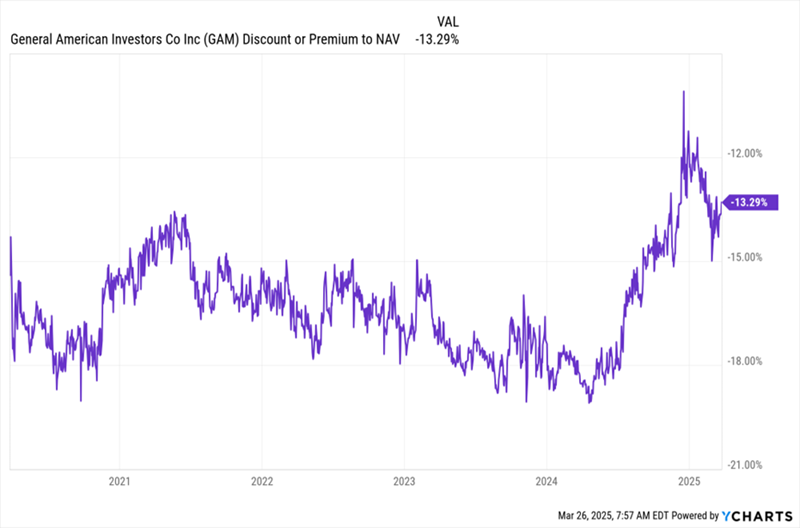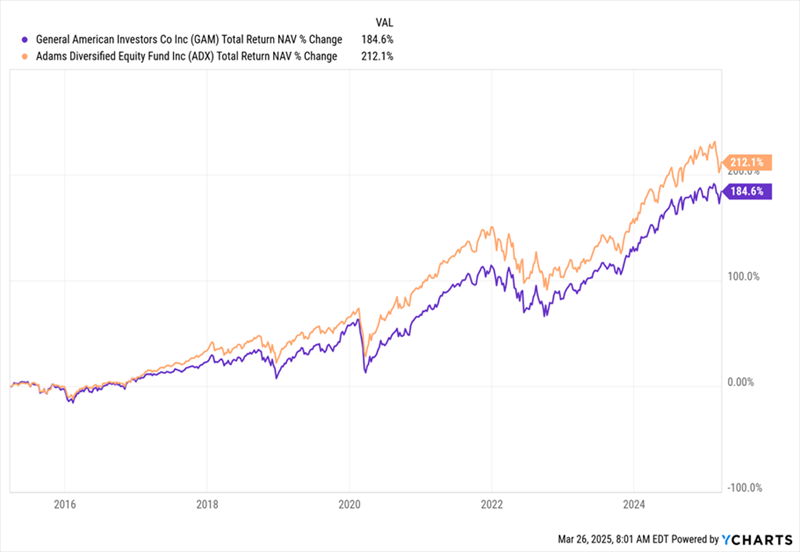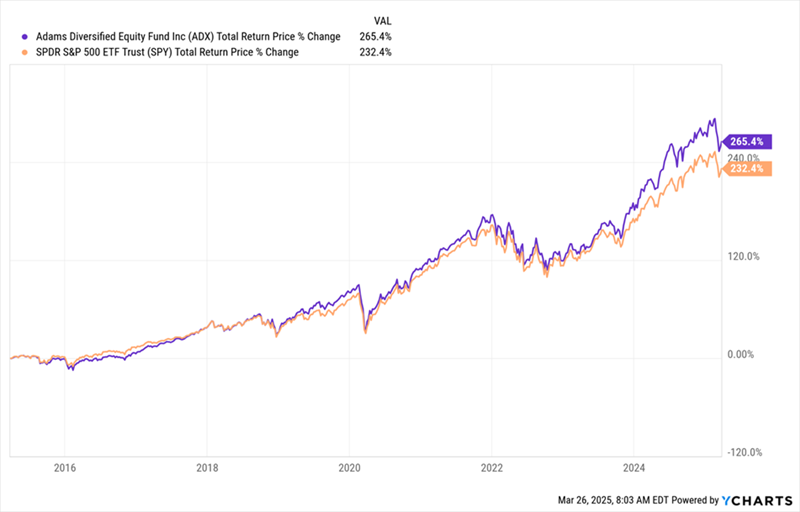Over the last couple of years, we’ve seen a quiet trend in investing—and today, we’re going to tap into it with two funds yielding nearly 10%.
That’s right: enough to pay you back just shy of 10% of your initial buy a year in dividends alone.
What’s more, these two income plays—closed-end funds (CEFs), to be precise—have been around for nearly a century, with one dating from 1927 and the other having launched in 1929. That last date, of course, is notorious, as it heralded the start of the worst market crash in history.
I bring these two CEFs up now because their long institutional memory gives them a level of reliability that few other funds can match. And there’s something else that favors both of them now, too—that quiet shift I mentioned earlier. I’m talking about the move from growth stocks to value stocks that’s started to pick up momentum in recent months.
We can catch a hint of that when we look at the performance of the large caps in the Dow Jones Industrial Average compared to small caps, as shown below by their benchmark index funds: the SPDR Dow Jones Industrial Average ETF Trust (NYSE:DIA), in orange below, and the small-cap-focused iShares Russell 2000 ETF (NYSE:IWM), in purple:
Large-Cap Split From Small-Cap Growth Plays

That nicely sets the table for our two centenarian funds.
“Centenarian” CEF Pick No. 1: General American Investors Company (GAM)
The General American Investors Company (NYSE:GAM) is the oldest of our two CEFs, but not by much. It’s been around since 1927 and holds reliable cash cows like Republic Services (NYSE:RSG), Apple (NASDAQ:AAPL), Alphabet (NASDAQ:GOOGL), Microsoft (NASDAQ:MSFT) and Berkshire Hathaway (NYSE:BRKa).
The fund has delivered an annualized return of 8.9% over the past decade, as of this writing. It’s caught our attention now because at my CEF Insider service, one of the things we look for is a fund with what I like to call “discount momentum.”
That’s where a CEF’s discount to net asset value (NAV, or the value of the fund’s underlying portfolio) is still wide but is slowly moving toward par. And that’s the setup we have with GAM now. Take a look.
GAM’s “Discount Momentum” Accelerates, Giving Us an In

Currently, GAM trades at a massive 13.3% discount, as you can see above, and that discount has been shrinking over the last year as market volatility prompts more investors to favor value over growth.
In the past year, GAM has also paid out a 9.3% dividend, which is a massive amount of income for one fund. Now it is true, that most of the fund’s income is paid out in one big yearly special dividend, so you’ll have to hold on to the fund for a full year to be guaranteed the full payout. But that’s a good thing: At CEF Insider, we see funds as something to be held for the long term.
“Centenarian” CEF Pick No. 2: Adams Diversified Equity Fund (ADX)
Our second fund, the Adams Diversified Equity Fund (NYSE:ADX) (ADX) was launched just a couple years after GAM, in 1929. That, of course, sent it headlong into the biggest market crash of them all, and the Great Depression. But that experience was the start of the fund’s build-up of the institutional memory that still helps guide its decisions today.
That’s a big part of the reason why we bought ADX in one of our first issues of CEF Insider, back in July 2017. Since then, it has delivered a 193% total return for us, as of this writing, showing its long-term mettle.
ADX and GAM take similar approaches, with Microsoft, Alphabet and Apple being common top positions, but ADX also has a large holding of NVIDIA (NASDAQ:NVDA), which is part of the reason why the fund has posted a bigger “NAV return” (or the performance of its underlying portfolio, including dividends collected) over the last decade. (ADX’s total NAV return is in orange below.)
ADX Outruns GAM

ADX’s strategy isn’t too risky, though, as it emphasizes investing in high-quality, large-cap companies, ensuring both growth potential and dividend reliability. Plus, its total dividend yield of 10.9% for 2024, combined with a relatively low management fee (for a CEF) of only 0.61%, makes ADX one of the cheaper CEFs on the fee front. On average, these funds have fees around 2% on average.
What’s unusual about ADX is that it has outperformed the market over the last decade and, over the last couple of years, the gap between its profits and those of the S&P 500—shown by the performance of the SPDR S&P 500 ETF Trust (SPY), in orange below, has grown wider:
ADX Dispels the Notion That Active Funds Can’t Beat the Market

ADX should trade at a premium for delivering these gains, yet it sports at an 11.4% discount as I write this. That means there’s upside as this “secret” income monster becomes more widely known. The move from growth to value, which we discussed with GAM above, should also help ADX move on to more people’s radar.
A Strategy for Using ADX or GAM to Build Long-Term Wealth
At this point, you might be wondering which fund is ideal: the cheaper GAM or the higher-performing ADX?
Ultimately, what matters with CEFs is that we combine the best funds in different asset classes—and funds with different investment strategies—while maintaining a high level of quality among our picks.
That way, when one falters due to a selloff, you can rebalance toward that dip-buying opportunity as another CEF outperforms. CEFs are particularly useful for this kind of rebalancing due to their high dividends (yields average around 8% as I write this). You’ll not only compound your returns by following this approach—you’ll build up a healthy income stream over time, too.
Disclosure: Brett Owens and Michael Foster are contrarian income investors who look for undervalued stocks/funds across the U.S. markets. Click here to learn how to profit from their strategies in the latest report, "7 Great Dividend Growth Stocks for a Secure Retirement."
